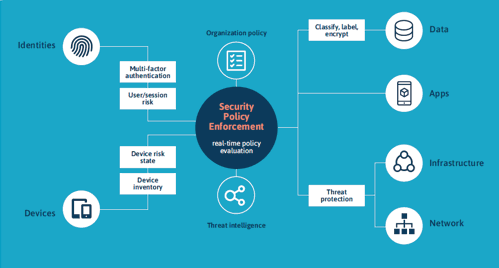The four pillars of Intelligent Security according to Microsoft
From firewall to zero trust
HSO Security Assessment identifies risks and advises recommendations

With the arrival of Cloud Technology and mobile computing, the IT landscape of most companies has changed dramatically. This new world calls for a different vision on security. Whereas companies used to secure their on-premise environment with a firewall, in other words a solid fence around all systems, we now see the rise of the zero-trust architecture: a security approach in which every part of your IT platform is secured separately.
In the HSO Security Assessment, we map out the weaknesses in your digital environment and provide a clear step-bystep plan on how you can optimise the security of your hybrid or cloud platform. You can read more about this in this factsheet zero trust approach and the security assessment.
The weaknesses in your IT platform
The risks of cybercrime are high. Sooner or later almost all companies will have to deal with it. You will not be the first organisation to fall victim to a crypto hack, where criminals encrypt your data and demand a ‘ransom’ for its release. Other major risks are loss of data, for example, stolen customer data, and the damage to company reputation. Cybercrime should always be high on the agenda, and if it happens to you, you want to be able to limit the damage as quickly and as much as possible.
We see that most hackers enter systems via stolen login data, via malware contained in e-mails or via stolen devices. That is why a complete security approach should include:
- Identities, logins, and access management
- Devices, laptops, phones, and tablets
- Data
- Applications
- Infrastructure
- Network
Why a zero-trust security approach?
An on-premise environment is usually protected by a firewall. In other words, a solid fence around all systems. Not only are cyber criminals getting smarter at penetrating firewalls, but there is also the risk that if a hacker does somehow gain access, he will soon get hold of all data and applications. It is also very important to note that a hack is not always immediately detected, with all the dangers that this entails. In addition to these risks, cloud technology and mobile working come with new threats. More and more employees have access to applications and data outside the ‘traditional’ company network boundaries. As a result, security via firewalls and virtual private networks (VPN) is no longer sufficient.
To meet these challenges, Microsoft has developed the Zero Trust Architecture.

The three principles of Zero Trust are:
1. Demand explicit verification
2. Give employees only access to the data and applications they need
3. Assume that you will be hacked
When setting up your security, Microsoft recommend that you continuously apply these principles. Does the last principle sound rather disturbing to you? Well, Microsoft call this realistic. However, you can prepare yourself as much as possible to make sure any damage is kept to a minimum.
A Zero-Trust model requires that all the components – user identity, device, network, and the applications - are continuously validated and tested for reliability.
The security strength of Microsoft
We are convinced that it is almost impossible to achieve the same level of on-premise security as you can reach with cloud security. Microsoft invests billions every year in the security of the Microsoft Cloud platform, and some 3,000 people contribute to this every day on a full-time basis. The strength of the Microsoft platform lies mainly in the enormous amounts of data, applications and information flows that are continuously being searched for, deviating signals, data flows or other disruptions using advanced algorithms. As a result, the level of security is becoming ever higher and increasingly automated, from which you, as a user of the Microsoft platform, can benefit from directly

1. Identity management and access control
A universal platform that allows you to manage and secure users (identities).
2. Threat protection
Integrated and automated security detects and stops cyber-attacks.
3. Information protection
Protect your business-sensitive information - wherever this data is stored or transmitted.
4. Cloud security
Protect your cloud applications.
This is how the HSO Security Assessment works
- 1
Determine as-is and to-be
Take stock of the ‘as-is’ status of your security and determine the requirements and preconditions of the ‘to-be’ situation. We draw up the requirements and pre-conditions based on legislation and regulations, standards in the market and, for example, expectations of customers and partners.
- 2
Inventory of your current IT landscape
We review what your current IT landscape looks like, including users, devices, applications, network, locations, and data.
- 3
Inventory of potential threats
We analyse the security risks and potential threats to your current environment and map them out for you
- 4
Assessment report and roadmap
The final step is a presentation of the report and our findings, plus a compact step-bystep plan to achieve a zero-trust security architecture
Timeline
In general, a turnaround time of 3-4 weeks is a sufficient timeline for the Security Assessment.
What do we ask of you?
For step 1, setting the frameworks and objectives, and step 4, the presentation, we ask for availability of the management and the IT team. For steps 2 and 3, we also ask for commitment from the IT team, with which we jointly map out the current platform and the possible weaknesses and risks
Keen to know more about the HSO Security Assessment?
Would you like to find out how you can benefit by taking the security of your hybrid or cloud platform to a higher level? Our experts are ready to assist you. Feel free to contact us!
